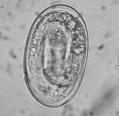Difference between revisions of "Dictyocaulus arnfieldi"
(Created page with '== Lungworm == === ''DICTYOCAULUS ARNFIELDI'' === ==== General ==== *Lungworm of equidae; adult worms found in smaller bronchi. Frequently incriminated as the cause of a chronic …') |
|||
| (21 intermediate revisions by 3 users not shown) | |||
| Line 1: | Line 1: | ||
| − | + | {{OpenPagesTop}} | |
| − | + | {{Taxobox | |
| − | ==== | + | |name =''Dictyocaulus arnfieldi |
| − | + | |kingdom = | |
| + | |phylum = | ||
| + | |class =[[:Category:Nematodes|Nematoda]] | ||
| + | |sub-class = | ||
| + | |order = | ||
| + | |super-family =[[Trichostrongyloidea]] | ||
| + | |family = | ||
| + | |sub-family = | ||
| + | |genus =Dictyocaulus | ||
| + | |species ='''''D. arnfieldi''''' | ||
| + | }} | ||
| + | [[Image:Dictyocaulus arnfieldi.jpg|thumb|right|150px|''Dictyocaulus arnfieldi'' from horse faeces - Joaquim Castellà Veterinary Parasitology Universitat Autònoma de Barcelona]] | ||
| + | Also known as: '''''Equine lungworm | ||
| − | == | + | ==Hosts== |
| − | + | Donkeys, and occasionally horses. | |
| − | |||
| − | |||
| − | == | + | ==Identification== |
| − | + | ''D. arnfieldi'' are of the superfamily [[Trichostrongyloidea]]. Adults are slender, thread-like and white. Females are larger than males at around 6.5cm in length. The males have a small non-lobulated bursa. | |
| − | |||
| + | The embryonated eggs are 80-100µm in length. | ||
| − | + | ==Life Cycle== | |
| + | The lifecycle is not greatly known, but it is currently thought to be similar to that of ''[[Dictyocaulus viviparus]]''. | ||
| − | + | The prepatent period is 2-3 months. | |
| − | |||
| − | |||
| − | | | + | {{Learning |
| − | | | + | |flashcards = [[Horse_Nematode_Flashcards|Horse Nematode Flashcards]] |
| − | | | + | |literature search =[http://www.cabdirect.org/search.html?rowId=1&options1=AND&q1=%22Dictyocaulus+arnfieldi%22&occuring1=title&rowId=2&options2=AND&q2=&occuring2=freetext&rowId=3&options3=AND&q3=&occuring3=freetext&x=42&y=10&publishedstart=yyyy&publishedend=yyyy&calendarInput=yyyy-mm-dd&la=any&it=any&show=all ''Dictyocaulus arnfieldi'' publications] |
| − | + | |Vetstream = [https://www.vetstream.com/canis/search?s=nematode Nematodes] | |
| − | + | }} | |
| − | |||
| − | |||
| − | |||
| − | |||
| − | |||
| − | | | ||
| − | |||
| − | |||
| − | |||
| − | |||
| − | |||
| − | |||
| − | |||
| − | |||
| − | |||
| − | |||
| − | + | {{review}} | |
| − | + | {{OpenPages}} | |
| − | |||
| − | |||
| − | |||
| − | |||
| − | |||
| − | |||
| − | |||
| − | |||
| − | |||
| − | |||
| − | |||
| − | + | [[Category:Dictyocaulus]][[Category:Horse_Nematodes]] | |
| − | + | ||
| − | + | [[Category:Expert_Review]] | |
| − | [[Category: | + | [[Category:Respiratory Parasitic Infections]] |
Latest revision as of 17:48, 4 June 2016
| Dictyocaulus arnfieldi | |
|---|---|
| Class | Nematoda |
| Super-family | Trichostrongyloidea |
| Genus | Dictyocaulus |
| Species | D. arnfieldi |
Also known as: Equine lungworm
Hosts
Donkeys, and occasionally horses.
Identification
D. arnfieldi are of the superfamily Trichostrongyloidea. Adults are slender, thread-like and white. Females are larger than males at around 6.5cm in length. The males have a small non-lobulated bursa.
The embryonated eggs are 80-100µm in length.
Life Cycle
The lifecycle is not greatly known, but it is currently thought to be similar to that of Dictyocaulus viviparus.
The prepatent period is 2-3 months.
| Dictyocaulus arnfieldi Learning Resources | |
|---|---|
To reach the Vetstream content, please select |
Canis, Felis, Lapis or Equis |
 Test your knowledge using flashcard type questions |
Horse Nematode Flashcards |
 Search for recent publications via CAB Abstract (CABI log in required) |
Dictyocaulus arnfieldi publications |
| This article has been peer reviewed but is awaiting expert review. If you would like to help with this, please see more information about expert reviewing. |
Error in widget FBRecommend: unable to write file /var/www/wikivet.net/extensions/Widgets/compiled_templates/wrt6932a8b07de495_21830085 Error in widget google+: unable to write file /var/www/wikivet.net/extensions/Widgets/compiled_templates/wrt6932a8b0a0b407_43487351 Error in widget TwitterTweet: unable to write file /var/www/wikivet.net/extensions/Widgets/compiled_templates/wrt6932a8b0c23147_82668280
|
| WikiVet® Introduction - Help WikiVet - Report a Problem |
